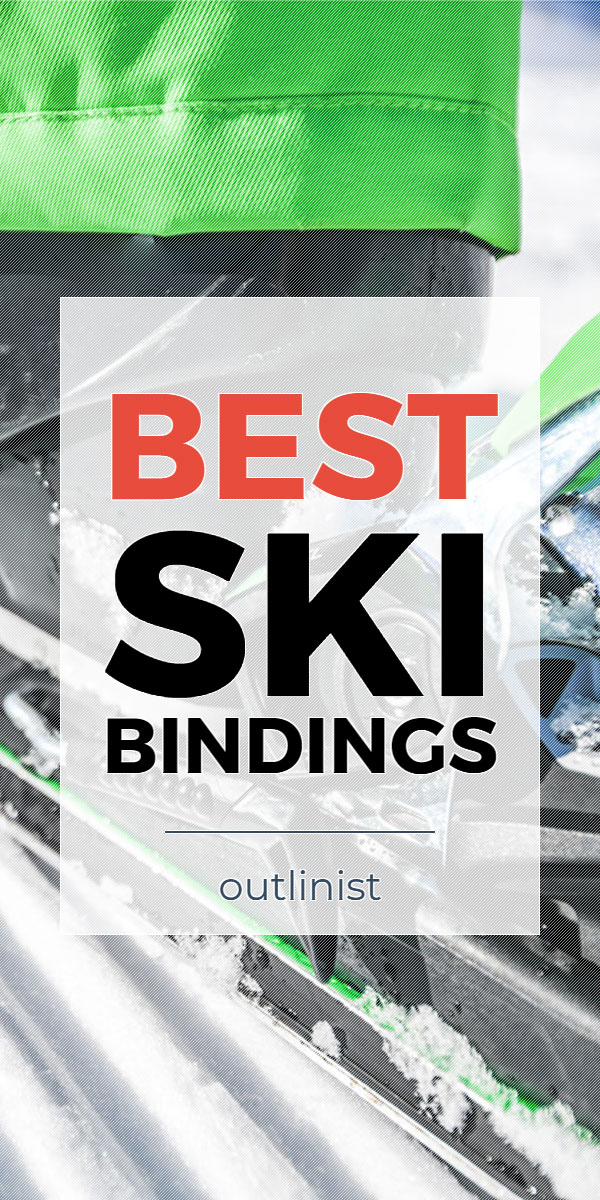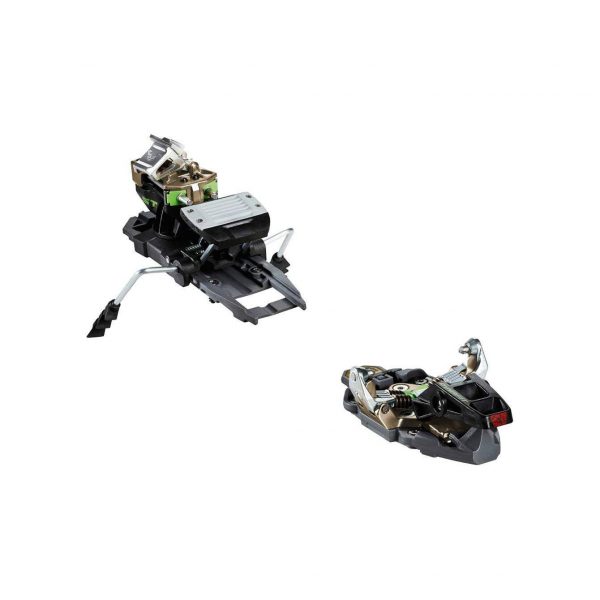
After 42 hours spent researching the best ski bindings, we think Dynafit Radical ST 2.0 Ski Bindings is the best for most people.
This choice is based on several criteria: ability level, type, best use, color, size, DIN / ISO range, stand height, skier weight, boot compatibility, heel piece, toe piece, brake width, adjustable, weight, and warranty, among other things.
| Product | Price | Overall Rating | Quality | Durability | Appearance | Maintenance | Value for Money | ability level | type | best use | color | size | DIN / ISO range | stand height | skier weight | boot compatibility | heel piece | toe piece | brake width | adjustable | weight | warranty | |
|---|---|---|---|---|---|---|---|---|---|---|---|---|---|---|---|---|---|---|---|---|---|---|---|
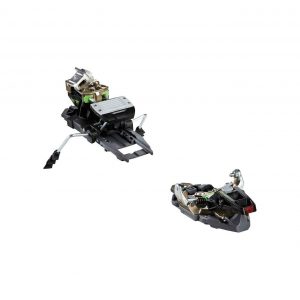 | Dynafit Radical ST 2.0 Ski Bindings | Check Price | 4.9 | 5.0 | 5.0 | 5.0 | 4.5 | 5.0 | Intermediate / advanced | Tech fit | All-mountain / downhill | Black | 90 to 135 mm | 5 to 13 | 36 mm | Not specified | Downhill & Alpine | High-tech | Pivot | Up to 105 mm | Yes | 3.8 lbs | 2 years |
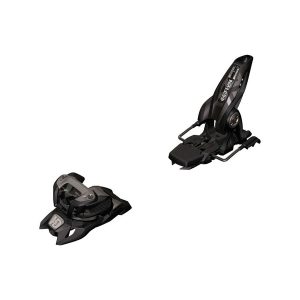 | Marker Griffon 13 ID Ski Bindings | Check Price | 4.8 | 5.0 | 4.5 | 4.5 | 5.0 | 5.0 | Intermediate / advanced / expert | Alpine | All-mountain / freeride | Black / white | 90 to 120 mm | 4 to 13 | 22 mm | Up to 265 lbs (120 kg) | Alpine & AT boots | One-piece | Pivot | Up to 110 mm | Yes | 4.19 lbs | 1 year |
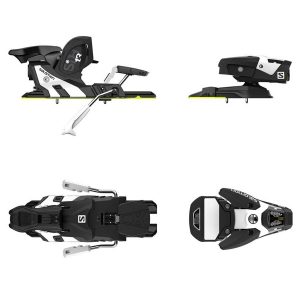 | Salomon STH2 WTR 13 Ski Bindings | Check Price | 4.6 | 5.0 | 4.5 | 4.0 | 4.5 | 5.0 | Advanced / expert | Alpine | All-mountain / backcountry | Black, white / Orange, black | 90 to 115 mm | 5 to 13 | 24 mm | Up to 275 lbs (125 kg) | Alpine & AT boots | Articulated | Fixed | Up to 130 mm | Yes | 3.41 lbs | 5 years |
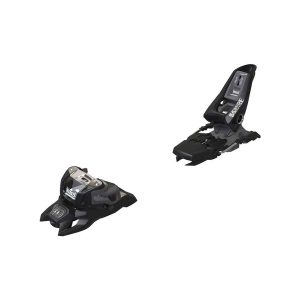 | Marker Squire 11 ID Ski Bindings | Check Price | 4.5 | 4.5 | 5.0 | 4.5 | 4.0 | 4.5 | Beginner / intermediate / advanced | Alpine | All-mountain / backcountry | Black / white | 90 to 110 mm | 3 to 11 | 22 mm | Up to 242 lbs (110 kg) | Alpine & AT boots | One-piece | Pivot | Up to 110 mm | Yes | 3.37 lbs | 1 year |
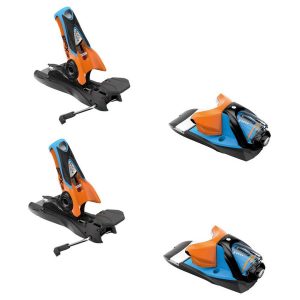 | Look SPX 12 Dual WTR Ski Bindings | Check Price | 4.3 | 4.5 | 4.0 | 4.0 | 4.5 | 4.5 | Intermediate / advanced | Alpine | All-mountain | 7 colors | 90 to 120 mm | 3.5 to 12 | 22 mm | Up to 280 lbs (127 kg) | Alpine & AT boots | One-piece | Fixed | Up to 120 mm | Yes | 2.45 lbs | 1 year |
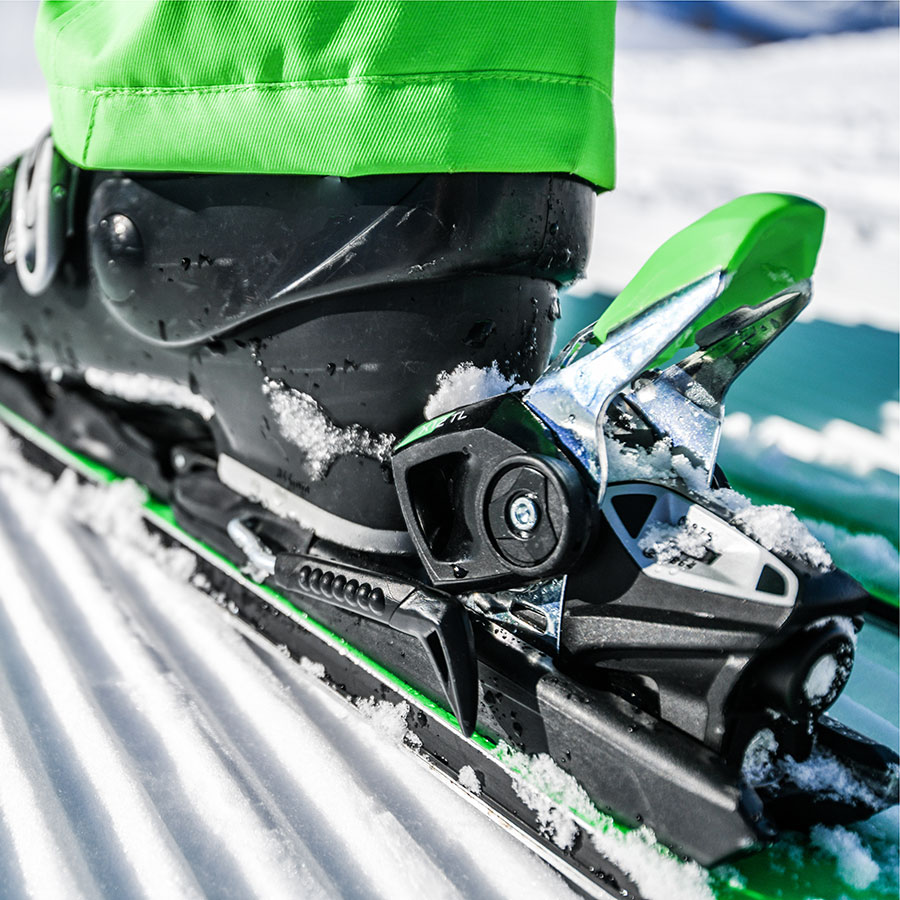
I have the best ski bindings, skiing today will be great! That sentence has probably never been uttered, but maybe it should.
Overlooked and underestimated, bindings do more than secure skier to ski, they keep you safe and can improve your ability.
There are two main things bindings do: release you from your skis when more pressure is exerted on them than the settings can handle and connect your body to your skis. Too bad a snowboard doesn’t release snowboard boots!
No matter if you spend the day on cross-country skis drawing pictures in the groomed tracks with your ski poles, or catch major air and hang like a snowboard wall mount, a good pair of bindings will have your body in good spirits after a long day on the slopes. They absorb shock from landings and all those bumps and lumps you will encounter on certain trails.
Unlike snowboard bindings, you need to know a bit more than riding style and skill level when choosing the right pair for your skis. You will also need to have your waist width and release force setting (DIN).
This leads to two very important rules when it comes to this particular piece of ski gear: (1) your ski boots must be compatible and (2) never adjust your DIN settings yourself. Once you have the width of your brakes and DIN, you can start having some fun with the other features available.
Fun features are the last things you want to worry about, though. Make sure you get a good pair.
Selection Of The Best Ski Bindings
Here are the best ski bindings for most people according to Outlinist:
Dynafit Radical ST 2.0 Ski Bindings

Sometimes you want to get to a mountain that the resort lifts aren’t going to. So you climb up the hill yourself because nothing is going to be better than that untouched powder.
The right ski bindings will get you there and back.
Alpine touring ski bindings can be very confusing. Some look more like hair pins or jewelry rather than lightweight ski bindings.
When considering how to choose ski equipment, especially gear as important as your bindings, you’ll want them to be light and easy to use, at the very least.
You have to know, not hope, your bindings are ready for anything.
Information
If compatibility is not an issue, you’re in luck because it has features that can take your touring season to the next level.
Dynafit has created an ISO/DIN certified tech binding that is comfortable, secure and safe. Dynafit Radical ST 2.0 Ski Bindings are good for intermediate and advanced skiers and come in several sizes: 90mm, 105mm, 120mm and 135mm and mostly in red/black but other colors may be found.
With a DIN range of 4-10, the Radical ST 2.0 is made for tech soles only, so make sure it’s compatible to your ski boot.
If you don’t know your DIN settings, a ski binding DIN calculator can help, but it’s best to see a professional. Once the DIN is set, remember adjusting the ski bindings’ DIN settings is something a professional should do for you.
| ability level | Intermediate / advanced |
|---|---|
| type | Tech fit |
| best use | All-mountain / downhill |
| color | Black |
| size | 90 to 135 mm |
| DIN / ISO range | 5 to 13 |
| stand height | 36 mm |
| skier weight | Not specified |
| boot compatibility | Downhill & Alpine |
| heel piece | High-tech |
| toe piece | Pivot |
| brake width | Up to 105 mm |
| adjustable | Yes |
| weight | 3.8 lbs |
| warranty | 2 years |
When choosing a ski brake width, a brake equal, or 15mm wider at most, to the width of your ski’s waist width will be compatible with this binding. It can handle some pretty wide skis if it needs to.
If compatibility is not an issue, you’re in luck because it has features that can take your touring season to the next level. A rotating toe piece lets you go slightly past your normal range with no worries about early release and the heel piece is easier to engage than ever. Both give this binding improved elasticity for safety and less of that vibration transfer, for a smooth ride.
Blending the proven performance of light tech bindings with the performance and safety of alpine bindings, these Dynafit bindings are high-quality touring tech bindings designed for those that like to climb and shred.
Pros
A metal plate now sits atop the heel piece instead of the once-used plastic.
Dynafit was the first brand to introduce tech bindings to the AT world and hasn’t stopped finding ways to improve their bindings and progress binding technology. The Radical ST 2.0 has broad appeal and can be seen with every serious tourer for a reason.
- Tech bindings that are safer than ever: This 2.0 model features a spring-tension, forward pressure type heel elasticity and pivoting toe piece that combine for better consistency in release values and more safety. Dynafit has really gone after that DIN/ ISO 13992 safety certification and it shows.
- Improved elasticity for a fun ride downhill: This upgraded Radical ST gives your legs a break with improved shock absorption. The new pivoting toe system on these bindings absorbs some of the vibrations, giving you a smoother ride and the chance to go downhill unlocked – if you dare.
- Easy transitions to walk/ski with an all-around winning heel piece: Its gapless design, moving up to 10mm, can now handle ski flex, compensating for forward impact. It is also multi-directional, meaning no more rotating the binding 360 degrees to switch into ski mode. Sturdy and durable, there’s an overall solid feel.
- Durable, long-lasting tech bindings that refuse to break: A metal plate now sits atop the heel piece instead of the once-used plastic. Designed to protect more important metal components, some pieces are made of plastic and are designed to break first. Dynafit has really thought the design out here.
- Chasing skis down the mountain is so 2018: Equipped with easy lock brakes, you can now independently engage or disengage the brakes, separately from the heel piece. No more watching your skis slide away when your bindings are in walk mode. Life is seriously about the small things.
- Alpine touring at its finest: Efficient, sturdy, lightweight and dependable, any backcountry skier will tell you these are some of the best alpine touring bindings. If you plan on touring over half of the time you are skiing, these Dynafit Radical bindings will not disappoint.
Cons
Offering similar features to its predecessor, this binding is undoubtedly more secure and safer. With such a marked improvement, it’s say to safe only the most loyal of Dynafit users will see these more minor criticisms as huge issues.
- Ability to get in the binding more easily would be awesome: The pivoting toe is great for added elasticity, but it makes locking into your bindings not so fun. To line your heel holes with rear pins, a backward glance helps, but misalignment means your heel is not locked and you can’t ski downhill.
- Can an added 0.05gm really feel this much heavier? More features mean more weight. The ST 2.0 is about half a pound heavier than its earlier version, but the improved safety is worth it right? If even the tiniest weight increase sets you off, you can get the brakeless version.
- Solid construction but care still needed: When snow builds underneath, releasing the toe piece requires some care because you may break the binding. Other pieces have fallen off with only small movements. This doesn’t happen often, but for the price, it should last a while before damage happens.
| Price | Check Price | Check Price | Check Price |
|---|---|---|---|
| ability level | Intermediate / advanced | Intermediate / advanced / expert | Advanced / expert |
| type | Tech fit | Alpine | Alpine |
| best use | All-mountain / downhill | All-mountain / freeride | All-mountain / backcountry |
| color | Black | Black / white | Black, white / Orange, black |
| size | 90 to 135 mm | 90 to 120 mm | 90 to 115 mm |
| DIN / ISO range | 5 to 13 | 4 to 13 | 5 to 13 |
| stand height | 36 mm | 22 mm | 24 mm |
| skier weight | Not specified | Up to 265 lbs (120 kg) | Up to 275 lbs (125 kg) |
| boot compatibility | Downhill & Alpine | Alpine & AT boots | Alpine & AT boots |
| heel piece | High-tech | One-piece | Articulated |
| toe piece | Pivot | Pivot | Fixed |
| brake width | Up to 105 mm | Up to 110 mm | Up to 130 mm |
| adjustable | Yes | Yes | Yes |
| weight | 3.8 lbs | 4.19 lbs | 3.41 lbs |
| warranty | 2 years | 1 year | 5 years |
Summary
Slightly heavier, most people will take this trade-off for the safety features and upgraded metal components.
Touting a few major upgrades, Dynafit Radical ST 2.0 Ski Bindings are some of the best touring bindings overall. Just as efficient as the earlier models, they come with improved safety and durability. They are ISO/DIN certified and have more consistent release values than before.
Slightly heavier, most people will take this trade-off for the safety features and upgraded metal components. The binding is difficult to get into the first couple tries but as you get used to aligning the pivoting toe piece, this minor annoyance will go unnoticed.
For those who love touring, this is the binding that will be with you through thick and thin. These ski bindings may not be the best in every category, but they do almost everything well.
Marker Griffon 13 ID Ski Bindings
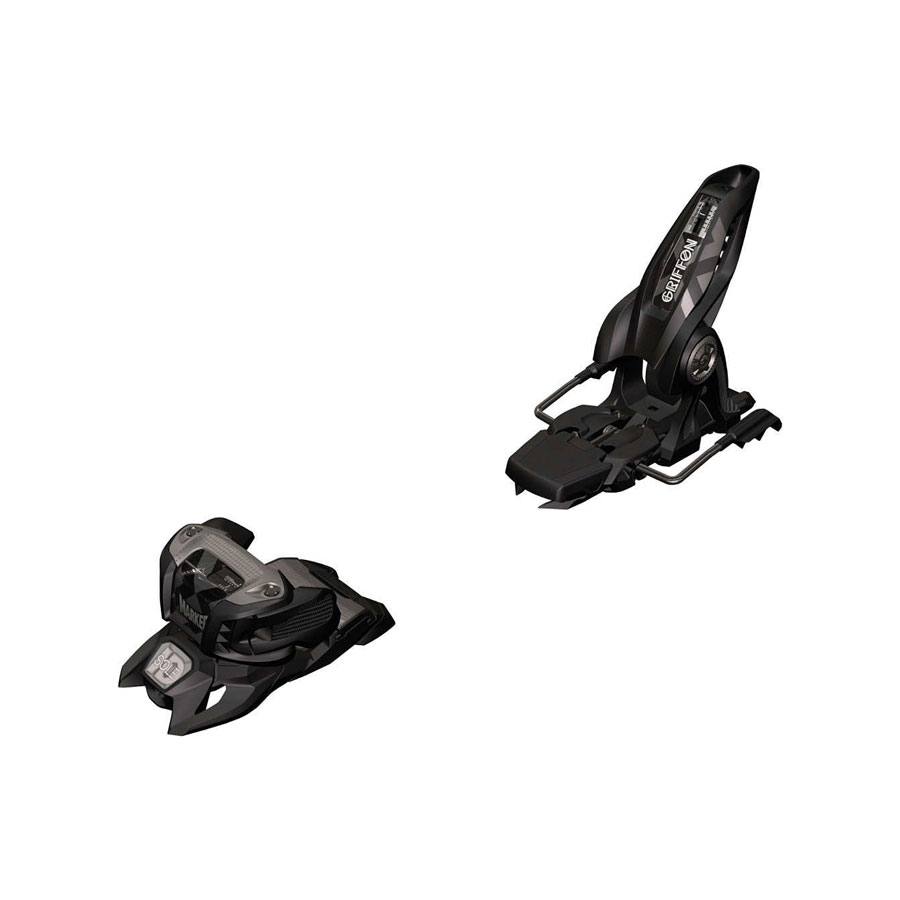
Ski bindings may not be on your mind until you start improving your skillset.
As you ski faster, pushing yourself harder, one thing becomes pretty clear: Skis that release early are just as dangerous as skis that don’t release at all.
Bindings designed to enhance your style of skiing can give you confidence, but can also weigh you down. It’s important to find those that are ideal for your current abilities but let you push your limits.
Performance, reliability and weight have made Marker’s bindings some of the best.
Getting the best bindings can transform what you thought you could do on the mountain.
Information
The versatility, adjustability, safety and uncompromising performance of these bindings have made them a favorite on the resort and backcountry.
As you progress as a skier, you realize very quickly that ski bindings do more than just attach you to your skis. The more you ski, the more you understand the power of a quality pair of bindings and what they can offer you as you race down the hill at full speed.
Your bindings can keep you from getting injured or can be the reason an injury occurs.
Marker Griffon 13 ID Ski Bindings allow you to challenge yourself but also keep you with a secure, in-control feeling at the same time. You never feel there is a jump you can’t land or mountain you can’t conquer and thanks to the anti-friction device (AFD), you’ll get a precise release when you need it.
| ability level | Intermediate / advanced / expert |
|---|---|
| type | Alpine |
| best use | All-mountain / freeride |
| color | Black / white |
| size | 90 to 120 mm |
| DIN / ISO range | 4 to 13 |
| stand height | 22 mm |
| skier weight | Up to 265 lbs (120 kg) |
| boot compatibility | Alpine & AT boots |
| heel piece | One-piece |
| toe piece | Pivot |
| brake width | Up to 110 mm |
| adjustable | Yes |
| weight | 4.19 lbs |
| warranty | 1 year |
Equipped with Marker’s Sole.ID, the bindings can be used with just about every kind of adult ski boot sole. The adjustable AFD makes adjusting them very easy. Available in black and white and ranging in sizes: 90mm, 110mm and 120mm, they are designed to work well with any ski, and specifically well for wide skis.
With a DIN range of 4-13, intermediate to advanced skiers are ideal for these bindings and they cover a wide range of styles, though the short binding allows for the spins and twists that are irresistible to park rats. They are also lightweight and make perfect kids’ ski bindings for those over 80 pounds.
The versatility, adjustability, safety and uncompromising performance of these bindings have made them a favorite on the resort and backcountry.
Pros
Designed to consistently release accurately, the risk of an early release is reduced greatly by the use of a triple pivot toe.
Next time you’re on the slope, look around. You’ll see this particular binding mounted to just about every set of skis. Lightweight, easy to install and amazingly stylish in black, chances are you’ll end up with a set of Marker Griffon bindings, too.
- No such thing as an incompatible boot: Don’t worry about buying multiple bindings for different ski boots anymore. These ski bindings can fit walk-to-ride, alpine and touring boots. How to adjust Marker Griffon bindings? Adjust the height of the anti-friction device. It takes just seconds to do!
- Romp around the entire mountain: One of the best park ski bindings, the pivot heel allows superior hold and elasticity for jibs, rails and anything else. Top-tier tech seamlessly balanced with performance make this binding a go-to choice for powder hounds and cruisers of the piste too.
- Confidence inspiring design & performance: Designed to consistently release accurately, the risk of an early release is reduced greatly by the use of a triple pivot toe. The best part? That unmistakable “thunk” when your bindings snap into place. You’ll rip the slope apart after you hear it.
- Great for skiers getting started or who want to progress: Touting some striking boot retention, bomber shock absorption and insanely fast responsiveness, Marker Griffon 13s are high on tech and performance, but low on the DIN range, making them ideal for intermediate and advanced skiers who fall on the lighter side.
- The wider the better! Purposefully designed to improve the performance of wider skis, the contact points on this binding are wider, making for better power transmission. You’ll also get a ton of torque on the edge of your ski due to a 22mm stand height.
- Bindings that don’t dip into your savings: Given the overwhelming amount of favorable Marker Griffon bindings reviews and the fact that they’re one of the best-selling bindings, you may automatically assume a hefty price tag is attached. Not the case with these. They are best sellers because they perform and are affordable.
Cons
Part of the Marker Royal Family bindings, Griffon 13s are versatile, secure and enhance your overall performance. There is a lot to love about these bindings and little to pick on. Not much can take away from a solid binding like this.
- Lighter weight binding is light: This binding gives you a ton of freedom when it comes to mobility but because they are designed to be extremely light in weight, heavier skiers with a more aggressive style may want something beefier and with a higher DIN.
- Good thing the price is affordable: These bindings have a fair amount of plastic components that may break after a fall or pop off easily. That being said, they are easy to fix, and super cheap. Note: Many skiers put them through the wringer with no problem.
- Difficult getting into for the lightest skiers: Already lightweight, some of the lightest skiers using these bindings can have a more difficult time than anyone else getting into the ski. With a bit of practice and some added strength while securing them, that “thunk” is sure to come.
| Price | Check Price | Check Price | Check Price |
|---|---|---|---|
| ability level | Intermediate / advanced / expert | Intermediate / advanced | Advanced / expert |
| type | Alpine | Tech fit | Alpine |
| best use | All-mountain / freeride | All-mountain / downhill | All-mountain / backcountry |
| color | Black / white | Black | Black, white / Orange, black |
| size | 90 to 120 mm | 90 to 135 mm | 90 to 115 mm |
| DIN / ISO range | 4 to 13 | 5 to 13 | 5 to 13 |
| stand height | 22 mm | 36 mm | 24 mm |
| skier weight | Up to 265 lbs (120 kg) | Not specified | Up to 275 lbs (125 kg) |
| boot compatibility | Alpine & AT boots | Downhill & Alpine | Alpine & AT boots |
| heel piece | One-piece | High-tech | Articulated |
| toe piece | Pivot | Pivot | Fixed |
| brake width | Up to 110 mm | Up to 105 mm | Up to 130 mm |
| adjustable | Yes | Yes | Yes |
| weight | 4.19 lbs | 3.8 lbs | 3.41 lbs |
| warranty | 1 year | 2 years | 5 years |
Summary
Besides being great freeski bindings, they are also used and loved by skiers with a variety of styles.
Fairly lightweight, Marker Griffon 13 ID Ski Bindings are designed to provide extreme energy consumption that greatly reduces the chance of a pre-release – perfect for bombing through choppy snow. Their short mounting zone also gives plenty of flex.
Besides being great freeski bindings, they are also used and loved by skiers with a variety of styles. These bindings will not restrict your ski’s flex and have a responsiveness that always makes you feel like you’re in control.
Highly recommended for intermediate skis and anyone with wide skis or who are just transitioning to wide skis, Griffon 13s are versatile, letting you fit most alpine, alpine touring and walk-to-ride boots. You get great performance and durability without needing a second job to purchase them.
Salomon STH2 WTR 13 Ski Bindings
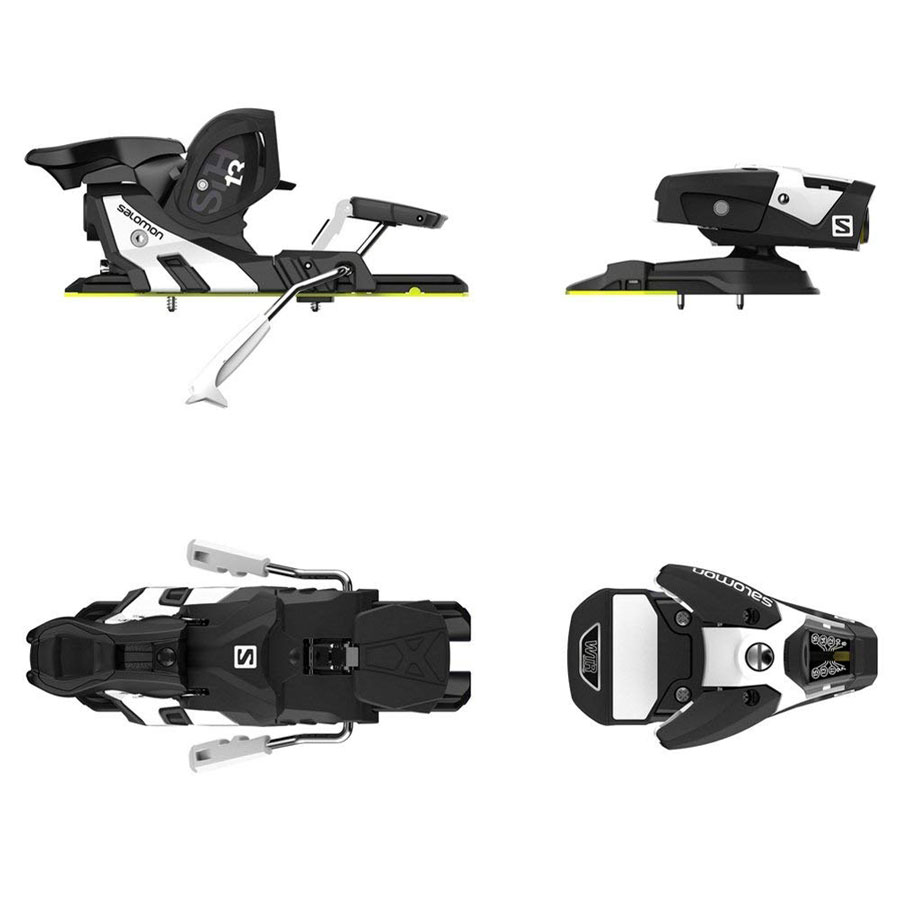
Ah yes. You are still holding on to those old ski bindings from your 18th birthday that you’ve somehow managed to convince yourself of being good luck or something.
How about you put it down slowly and find something a bit more updated?
There’s a heavy focus on bindings that help the more adventurous skier get to more parts of the mountain.
Though many traditional bindings remain the same, there are quite a few now that offer a great deal more versatility than before.
For more exploring outside the resort, a tough, versatile binding that can handle touring boots may do the trick.
Information
Designed to inspire your best performance, they come with enough elasticity to remove any fears of pre-release and a 3D design that dampens shock on the toughest landings.
Superior bindings do more than just perform. They make you want to stretch your limits – whether that’s going on your first touring adventure or perfectly landing after catching massive air, is up to you.
Salomon STH2 WTR 13 Ski Bindings let you experience precision and power. With a wide DIN range (a Salomon DIN chart will come in handy), these lightweight bindings are great for those who like shooting down tall, snow-covered earth hard. They definitely don’t mind being pushed.
The STH2 WTR 13 bindings are compatible with various boot types. No matter where you decide to take them, you’ll get a reliable and durable binding that gets you up or down the mountain.
| ability level | Advanced / expert |
|---|---|
| type | Alpine |
| best use | All-mountain / backcountry |
| color | Black, white / Orange, black |
| size | 90 to 115 mm |
| DIN / ISO range | 5 to 13 |
| stand height | 24 mm |
| skier weight | Up to 275 lbs (125 kg) |
| boot compatibility | Alpine & AT boots |
| heel piece | Articulated |
| toe piece | Fixed |
| brake width | Up to 130 mm |
| adjustable | Yes |
| weight | 3.41 lbs |
| warranty | 5 years |
Wide skis? Of course you have wide skis. This binding is ready for you with an oversized platform created to improve control and torque for the widest set of skis. In a nice range of sizes (90mm, 10mm, 115mm and 130mm) and most commonly available in black/white and black/orange, it’s a stylish binding found everywhere on the mountain.
Designed to inspire your best performance, they come with enough elasticity to remove any fears of pre-release and a 3D design that dampens shock on the toughest landings. If you’re a freestyler at heart, you’ll appreciate the insane amount of energy transfer that you’ll receive from the low-profile chassis.
For the price, you’ll think these are discount ski bindings as opposed to the well-respected name attached to them. Salomon really just keeps on giving to the ski community.
Pros
A binding that is good for any set of skis, downhill, aggressive skiers have discovered the magic of the STH2.
Featuring tons of adjustability and user friendliness, the STH2 WTR 13 bindings never sacrifice safety for performance. A legend due to its precise energy transmission, this binding can take a hard beating on the slopes for many seasons. No fuss, no muss.
- Alpine touring boot compatibility: Able to be fully adjusted to various types of boots, the STH2 can be used with WTR boots and classic alpine soles, offering you some versatility in your ride on the mountain. They will also save you a few extra dollars.
- Low riding things of beauty: The low profile of the chassis keeps you close to your skis, heightening the sensitivity you’ll feel to the terrain you’re shredding and providing more power transfer. The more contact you have with your skis, the better your intuition on the slope.
- Tucked in, safe and secure: With ample elasticity equipped in the toe, pre-release is prevented by allowing your ski boot greater movement within the binding. This binding features some top-notch release if you find yourself spilling out of your skis. This improves the overall safety and confidence.
- Workhorse binding for aggressive skiers: A binding that is good for any set of skis, downhill, aggressive skiers have discovered the magic of the STH2. Providing great power transmission on their wider skis and a sturdy feel, these Salomon ski bindings are proven to be durable.
- Soft snow lover’s binding of choice: If you’re fond of deep powder, this is one of the best bindings for powder skis simply due their sheer ease. The stubby wings align the boot for quick heel entry, making the STH2 WTR 13s extremely easy to step into, especially in powder.
- Stable, smooth freestylin’ ride: Fitted with self-retracting freestyle ski brakes, you’ll have increased precision on switch landings. What really makes these nice freestyle ski bindings are the transfer pads that dampen vibrations on park airs. Style aside, you’ll have a smooth, damp ride.
Cons
A favorite for those who love charging downhill, the smooth ride offered by these Salomon ski bindings is first-rate. However, those at the extreme end of the range this binding is meant for may not get the same exhilarating experience.
- Uneven weight distribution: The maximum DIN makes the STH2 WTR 13 binding ideal for lighter-weight skiers, a good choice for some women’s skis. Those who are on the heavier side may experience a less-than-thrilling ride down the mountain as they fight to distribute their weight evenly.
- Toe adjustment issues: The toe height can be adjusted in order to swap out different boot soles. Over time, however, a problem can develop where the toe height adjustment can no longer be lowered enough for the classic alpine sole boots to fit.
- Not much for advanced & expert downhill skiers: If you are riding these at the higher end of their DIN range, be aware there have been a number of early release issues. Setting the DIN anywhere from 11 to 13 is a risk, so considering bumping up to the next model.
| Price | Check Price | Check Price | Check Price |
|---|---|---|---|
| ability level | Advanced / expert | Intermediate / advanced | Intermediate / advanced / expert |
| type | Alpine | Tech fit | Alpine |
| best use | All-mountain / backcountry | All-mountain / downhill | All-mountain / freeride |
| color | Black, white / Orange, black | Black | Black / white |
| size | 90 to 115 mm | 90 to 135 mm | 90 to 120 mm |
| DIN / ISO range | 5 to 13 | 5 to 13 | 4 to 13 |
| stand height | 24 mm | 36 mm | 22 mm |
| skier weight | Up to 275 lbs (125 kg) | Not specified | Up to 265 lbs (120 kg) |
| boot compatibility | Alpine & AT boots | Downhill & Alpine | Alpine & AT boots |
| heel piece | Articulated | High-tech | One-piece |
| toe piece | Fixed | Pivot | Pivot |
| brake width | Up to 130 mm | Up to 105 mm | Up to 110 mm |
| adjustable | Yes | Yes | Yes |
| weight | 3.41 lbs | 3.8 lbs | 4.19 lbs |
| warranty | 5 years | 2 years | 1 year |
Summary
The ever-trustworthy Salomon driver toe ups the elasticity in your boot, reducing the risk of pre-release and dampens vibrations and shocks for smooth rides or smooth landings.
Something of the new wave, Salomon STH2 WTR 13 Ski Bindings have a very wide DIN range that goes all the way up to 13, giving amazing energy transference and compatibility with WTR soles. Updated for the modern, wide ski seen everywhere these days, this ski binding likes to be put to work.
The ever-trustworthy Salomon driver toe ups the elasticity in your boot, reducing the risk of pre-release and dampens vibrations and shocks for smooth rides or smooth landings. Great for intermediate aggressive riders, this binding also does well in powder, providing easy click in time after time.
If you still have those crusty old bindings that you swear are still great, these ski bindings are begging you to step into the future.
Marker Squire 11 ID Ski Bindings
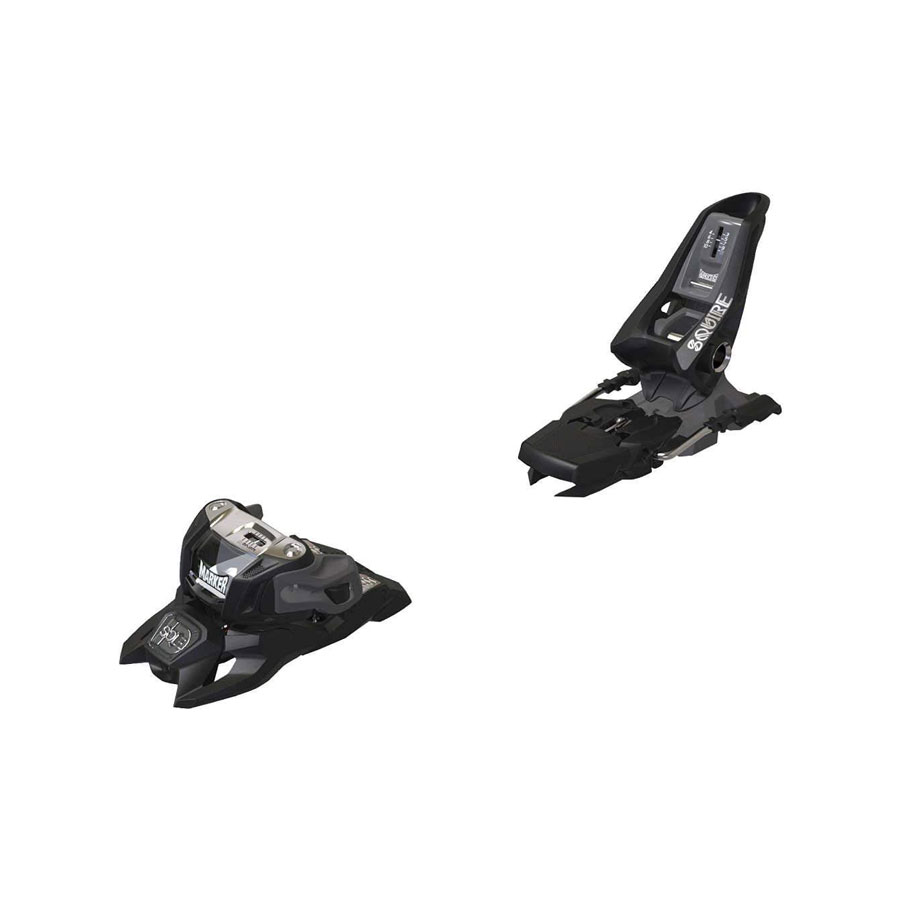
So much focus is put on investing in the correct ski boots, which leads a lot of people to ignore the importance of ski bindings.
While having quality boots is critical, ski bindings are also an essential element of the setup to ensure that you can ski safely.
The purpose of bindings is to keep your boots and skis attached to each other and they serve as the primary mechanism to control your skis.
If you happen to bail on your run at any point, the bindings will release your skis so that you do not get hurt.
It is why investing in quality bindings that are the ideal fit for you is so crucial.
Information
These bindings are very light, at just over 1500 grams. They feature SOLE.ID technology, which allows them to work with ski boots of different styles.
If you have ever watched a skiing competition, you have probably noticed there is a contraption connecting a skier’s boots to their skis. These contraptions are ski bindings.
With the best ski bindings, you can keep your boots connected to your skis for maximum control. And quality bindings will also allow for an immediate release of the skis from your boots if you need to bail out, without causing any serious injury.
Bindings typically have a toe and heel piece. The toe piece will almost always release sideways, while the heel piece can release up or in different directions. It is important to invest in bindings such as the Marker Squire 11 ID Ski Bindings, as they feature an anti-friction device to allow for a smooth release of your skis.
| ability level | Beginner / intermediate / advanced |
|---|---|
| type | Alpine |
| best use | All-mountain / backcountry |
| color | Black / white |
| size | 90 to 110 mm |
| DIN / ISO range | 3 to 11 |
| stand height | 22 mm |
| skier weight | Up to 242 lbs (110 kg) |
| boot compatibility | Alpine & AT boots |
| heel piece | One-piece |
| toe piece | Pivot |
| brake width | Up to 110 mm |
| adjustable | Yes |
| weight | 3.37 lbs |
| warranty | 1 year |
When you’re learning about how to choose ski bindings, you must understand DIN. The DIN setting tells you how easily the bindings release the skis. It is a calculation done that factors in your ski style, weight, height, age and boot length. The Marker Squire bindings have a DIN rating of 3.0 to 11.0, which means they are perfect for women, beginner skiers, and lighter men who ski at an advanced level.
These bindings are very light, at just over 1500 grams. They feature SOLE.ID technology, which allows them to work with ski boots of different styles. And they are made with durable materials, including aluminum.
Lighter skiers who need a reliable pair of bindings that will last them a very long time cannot go wrong with Squire 11 ID bindings.
Pros
Lighter skiers or those who are new to the sport will be best served with these bindings, as they have the appropriate DIN range to accommodate such skiers.
If you are searching for an affordable and durable set of ski bindings, it is hard to go wrong with the Squire 11 ID. They have all the elements needed to ski safely and transfer energy and direction to the skis. Here are the six best features of this product.
- Suitable for most types of skiers: Marker has designed the Squire bindings with all types of skiers in mind. Even someone who is lesser experienced will be happy with them, while lighter skiers who try advanced moves will also get great performance.
- Features a unique SOLE.ID technology: The concept of SOLE.ID from Marker is to ensure that its bindings are compatible with many different types of boots. They work with alpine boots, ski boots that have touring soles, and other varieties. Retention and smoothness is optimized across boot types.
- Includes an anti-friction device plate in the toe area: Having this AFD plate ensures that shock is absorbed during the pre-release and release phases. When necessary, the plate also helps with lateral release, which reduces the chance of an injury when releasing the skis as you are going downhill.
- DIN range of 3.0 to 11.0: Lighter skiers or those who are new to the sport will be best served with these bindings, as they have the appropriate DIN range to accommodate such skiers. And the bindings only weigh 1500 grams, which means they offer a very lightweight experience.
- Unique toe design: The Triple Pivot design on the toe uses independent wings on a horizontal spring. It helps with the smooth release of the skis when necessary, while allowing for maximum grip and control.
- Available in two colors and sizes: If you are considering investing in these Marker bindings, then you will be pleased to know they are available in two colors. You can get them in black or white, ensuring your bindings match up with the rest of your ski gear. They also come in 90mm and 110mm size options.
Cons
Investing in Marker’s Squire bindings will ensure that you are safe and in control when you’re cruising down the mountain. But they are not faultless. Here is a look at three shortcomings that are worth considering.
- Manufacturer only offers a one year warranty: Buyers will be disappointed to learn that Marker Bindings warranty on this Squire model is only for 12 months. If you are planning to use these bindings very often for a few years, then you may consider going with a product that offers a two or three year warranty.
- Not ideal for aggressive skiers over a certain weight and height: If you are an aggressive skier who is over 200 pounds and taller than 200 cm (about 6.5 feet), then you will be a little limited by the DIN range. Those outside of that category should be very happy with this product.
- May not be suitable for park riders: When you are riding park, you are putting a great deal of stress on the bindings. Given the lightweight nature of these Squire bindings, you could run into performance issues. It may be best to go with a slightly heavier set if you are an avid park rider.
| Price | Check Price | Check Price | Check Price |
|---|---|---|---|
| ability level | Beginner / intermediate / advanced | Intermediate / advanced | Intermediate / advanced / expert |
| type | Alpine | Tech fit | Alpine |
| best use | All-mountain / backcountry | All-mountain / downhill | All-mountain / freeride |
| color | Black / white | Black | Black / white |
| size | 90 to 110 mm | 90 to 135 mm | 90 to 120 mm |
| DIN / ISO range | 3 to 11 | 5 to 13 | 4 to 13 |
| stand height | 22 mm | 36 mm | 22 mm |
| skier weight | Up to 242 lbs (110 kg) | Not specified | Up to 265 lbs (120 kg) |
| boot compatibility | Alpine & AT boots | Downhill & Alpine | Alpine & AT boots |
| heel piece | One-piece | High-tech | One-piece |
| toe piece | Pivot | Pivot | Pivot |
| brake width | Up to 110 mm | Up to 105 mm | Up to 110 mm |
| adjustable | Yes | Yes | Yes |
| weight | 3.37 lbs | 3.8 lbs | 4.19 lbs |
| warranty | 1 year | 2 years | 1 year |
Summary
They are designed to work with any type of ski boot, whether it is an alpine boot or a boot that features a touring sole.
The Marker Squire 11 ID Ski Bindings are perfect for intermediate and lightweight advanced skiers. If you are hoping to get reliable power transmission and a freeride binding, you have found your ideal product.
They are designed to work with any type of ski boot, whether it is an alpine boot or a boot that features a touring sole. Thanks to the SOLE.ID feature, making adjustments to the bindings is very easy.
You have invested money in quality skis and ski boots. Now you have to find the ideal ski bindings to link the two of them together, so you are ready to hit the slopes. These Marker Squire bindings are an excellent option.
Look SPX 12 Dual WTR Ski Bindings
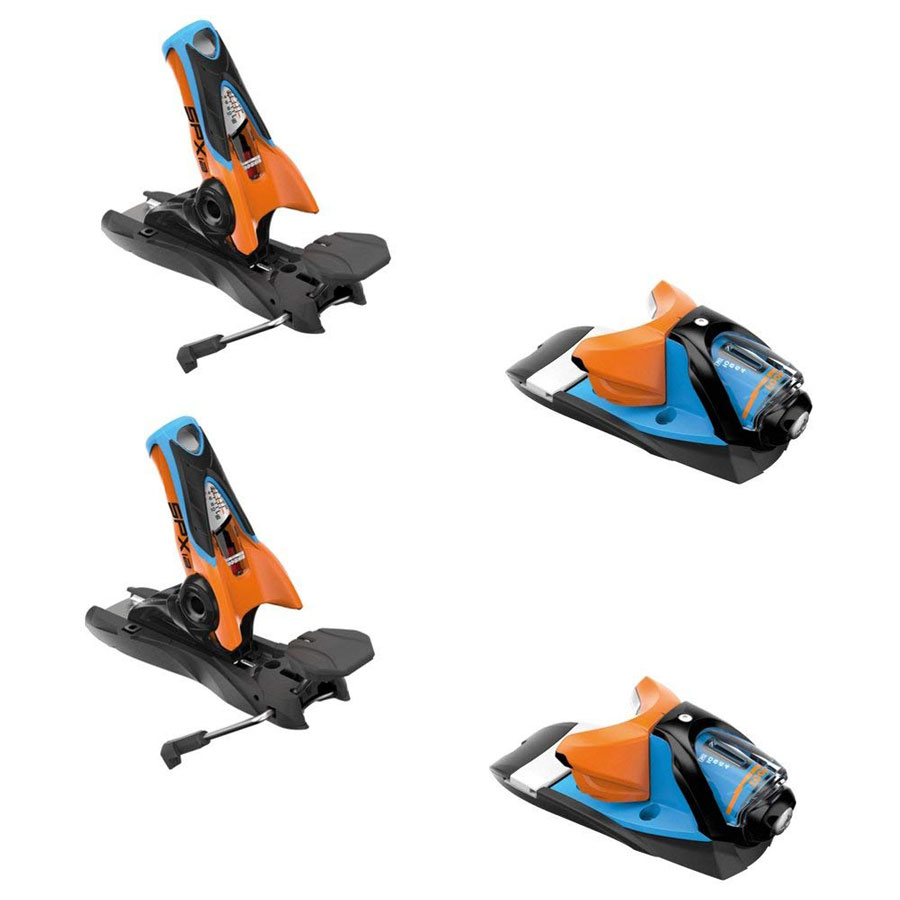
When you are planning a fast paced drop down a steep slope, every bit of your ski gear must do its job perfectly.
Most people focus a lot on high-quality skis and boots without thinking about ski bindings.
But it is vital to have high-performance bindings that can handle the force that is being exerted when you are ripping down a tough slope.
Bindings should deliver a perfect attachment between your boots and skis, ensuring complete control and maneuverability.
They should also have a mechanism that allows for an easy, shock absorbing release should you bail halfway through a downward trip.
Information
Look SPX 12 bindings are perfect for downhill skiing, while both intermediate and advanced users will be very pleased with the amount of force they can handle.
Before you invest in quality ski bindings, you must understand the DIN setting. It is the industry standard scale that determines the release force setting for various types of bindings. A lower DIN works for casual skiers who are shorter and lighter, while a higher number corresponds to heavier and/or more aggressive skiers.
The Look SPX 12 Dual WTR Ski Bindings have a DIN range of 3.5 to 12.0, meaning that skiers of different styles, heights, weights and shoe sizes will be very pleased with the product.
If you are concerned about how to adjust Look ski bindings, you should take your gear to a professional ski shop. They will get everything setup so that your bindings are perfectly linked up to your skis and boots.
| ability level | Intermediate / advanced |
|---|---|
| type | Alpine |
| best use | All-mountain |
| color | 7 colors |
| size | 90 to 120 mm |
| DIN / ISO range | 3.5 to 12 |
| stand height | 22 mm |
| skier weight | Up to 280 lbs (127 kg) |
| boot compatibility | Alpine & AT boots |
| heel piece | One-piece |
| toe piece | Fixed |
| brake width | Up to 120 mm |
| adjustable | Yes |
| weight | 2.45 lbs |
| warranty | 1 year |
In terms of sizes, you get a 100mm and 120mm option with this model, which should work for most skiers. If you are unsure about the ideal size, consult a ski binding size chart from the manufacturer before buying the product.
Look SPX 12 bindings are perfect for downhill skiing, while both intermediate and advanced users will be very pleased with the amount of force they can handle. Skiers who weigh between 110 to 210 pounds can use these bindings which are suitable for both men and women.
If you are searching for an affordable set of bindings that will last you many years on the slopes, then you will be very happy with Look’s SPX 12 bindings.
Pros
Whether you are planning to use ski boots with Alpine, Walk to Ride or GripWalk soles, you will have no issues pairing them up with these high performance ski bindings.
If you are a high performance skier who wants to get the very best, you will be very happy with the quality on offer with the SPX 12 bindings. Here are some features that illustrate their quality.
- Look has added a toe upgrade to their best bindings: The previous editions of the SPX 12 were already excellent, but Look has added a Full Toe Drive design to the latest edition to ensure they deliver even better stability, control and performance.
- Very wide DIN range: A DIN range of 3.5 to 12.0 means that skiers as light as 110 pounds or as heavy as 210 pounds can make use of these bindings. Unless you know how to adjust ski bindings, it is important to get them adjusted by a professional before first use.
- They work with different boots: Whether you are planning to use ski boots with Alpine, Walk to Ride or GripWalk soles, you will have no issues pairing them up with these high performance ski bindings.
- Heel design offers a lot of shock absorption: Thanks to an innovative heel design, these bindings provide roughly 27mm of elastic travel. It means that when skis are being released, you are not going to feel too much shock or suffer a serious injury.
- Available in three sizes and two color options: The SPX 12 bindings are available in 90mm, 100mm and 120mm sizes, while you can choose between black and concrete/yellow styles. Having such options is helpful, as you can better match your bindings to the colors of your boots and skis.
- Relatively lightweight: While there are lighter bindings on the market, they do not offer the same DIN range as the SPX 12 Dual bindings. With a roughly 2100 gram weight as a pair, these bindings are very lightweight considering they can handle skier weight up to 210 pounds.
Cons
Look SPX 12 bindings are the perfect product for someone who is seeking a high-performance, all-mountain set of ski bindings that can handle the pressure being put on them. But these products do have issues, as highlighted by our three product cons.
- Kids or very lightweight skiers may face issues: Given their DIN range of 3.5 to 12.0, skiers who are between 92 to 105 pounds and roughly 150cm in height (a little less than 5 feet) may need to find a model that has a lower DIN range. That is especially true if those skiers are beginners.
- Only a one year warranty: Although this shouldn’t be a huge concern for casual skiers, those who ski regularly will be disappointed their bindings are only under warranty for one full season.
- Not ideal for heavier or aggressive skiers: A DIN maximum of 12.0 covers most skiers, even advanced ones. But if you weigh over 210 pounds and ride in an aggressive style, then a DIN of 12 is not enough. You may need to find another product.
| Price | Check Price | Check Price | Check Price |
|---|---|---|---|
| ability level | Intermediate / advanced | Intermediate / advanced | Intermediate / advanced / expert |
| type | Alpine | Tech fit | Alpine |
| best use | All-mountain | All-mountain / downhill | All-mountain / freeride |
| color | 7 colors | Black | Black / white |
| size | 90 to 120 mm | 90 to 135 mm | 90 to 120 mm |
| DIN / ISO range | 3.5 to 12 | 5 to 13 | 4 to 13 |
| stand height | 22 mm | 36 mm | 22 mm |
| skier weight | Up to 280 lbs (127 kg) | Not specified | Up to 265 lbs (120 kg) |
| boot compatibility | Alpine & AT boots | Downhill & Alpine | Alpine & AT boots |
| heel piece | One-piece | High-tech | One-piece |
| toe piece | Fixed | Pivot | Pivot |
| brake width | Up to 120 mm | Up to 105 mm | Up to 110 mm |
| adjustable | Yes | Yes | Yes |
| weight | 2.45 lbs | 3.8 lbs | 4.19 lbs |
| warranty | 1 year | 2 years | 1 year |
Summary
Look designed these bindings with an oversized heel pivot, ensuring that you have greater coupling strength and a more efficient transmission of power.
With the Look SPX 12 Dual WTR Ski Bindings, you are getting the best ski bindings for all-mountain skiing, especially if you are a high performance skier. The DIN range of these bindings is 3.5 to 12.0, meaning that heavier skiers who have an aggressive style will be happy with the product.
Look designed these bindings with an oversized heel pivot, ensuring that you have greater coupling strength and a more efficient transmission of power. And they work with both Walk to Ride and Alpine boot soles, delivering the type of flexibility that is not always found in comparably priced models.
If you are seeking the best all-mountain ski bindings that you can buy on a modest budget, you will be very pleased with the SPX 12. They are a quality product made by a company that has an excellent reputation in this sector.
Buying Guide
Release force settings (DIN)
Based on your height, age, weight, skill level and boot size, the DIN range determines the right amount of force that needs to be applied to let you out of your skis in order to prevent injury. The higher the DIN range, the more durable it is designed to be. Some people write it on their ski boots bag so they don’t forget it.
All bindings offer a range of release settings. Low release settings are great for beginners as the ski will release easily. Higher settings are used by more advanced and aggressive skiers, free riders and freestylers.
Brakes
You don’t want your skis to keep going after you’ve stopped. Brakes keep your skis from running down the mountain after they’ve been released so they don’t put other skiers in harm’s way and so you can retrieve them fast and get back to carving.
Your ski waist determines the width of your ski brake. If the brake is too narrow, it will not clear the edges of your skis and cannot work properly. If the brakes are too wide, they can drag, especially on steeper terrain. If you have powder skis, you’ll typically want a larger brake.
Alpine/downhill bindings
Made for alpine boots and best for all-mountain skis, freeride and freeski bindings are all similar: they have a toe piece, a heel piece, brake, and all are made to release during a fall to reduce the risk of injury. They also will offer height adjustment and various widths to accommodate skis.
When choosing the best downhill bindings for your style and ability, beginners should focus on their DIN setting, while experienced skiers typically prioritize the bindings’ retention instead of its release.
Race bindings
Made for speed, these are typically stronger and heavier than other types of downhill bindings. More metal is used for added durability and they have higher DIN ranges that can accommodate higher speeds.
The best race bindings will incorporate technology that helps transmit your moves faster and keep the bindings stable when racing.
Frame Bindings
Similar to downhill, these have a toe and heel piece, but they are connected by a plastic or metal frame. Made for backcountry skis, skiers are able to climb the slopes by unlocking their heel piece and locking it back in when descending, for a downhill-like performance.
Designed for alpine touring, these operate like downhill and are chosen using the DIN settings and personal preference. If your tracks must be the first ones in the snow, this is an option for you.
Tech bindings
Another backcountry binding, this one is used by serious ski tourers only. These special bindings use your actual ski boot as the frame and require specially made molded-in toe heel boots. The boots use special steel fittings to create its frame.
You won’t always find them with a DIN-certified release rating, and some of them do not even come with brakes. Give these lightweight ski bindings a chance. Grab your ski backpack and get moving uphill.
Telemark bindings
Very specific to the telemark style of skiing, they can only be used with telemark boots. The heel of the boot does not lock, and the skier’s heel travels freely up and down, even when you’re skiing down the slope. These have no release feature when the heel is free-moving.
The toe of the binding is fixed and can come with a cable and heel throw. Because variation is limited, there’s not as much choice for telemark bindings as there is with bindings for downhill skis or even snowshoes, so the ones you buy will largely come down to style preference.
Elastic movement
The elasticity of your equipment goes a long way in keeping you safe and upping your performance. Before the bindings are forced to release your boot, your toe and heel have some room to move around (elasticity). They are designed this way to reduce accidental releases and absorb a substantial amount of shock during bumps and landings.
Generally, most bindings will let the boot around 5mm, but some brands offer models with a greater range of movement. The higher the elasticity, the greater the range.
Strength, materials used
Stronger skiers need stronger equipment. The materials your bindings are made with can determine their strength, durability, shock absorption, weight and power transmission.
This becomes important for skiers focused on performance. Bindings that have a higher DIN designed with skill in mind tend to be built with stronger materials to accommodate traveling faster and conquering steeper, more challenging terrain. If you fall into this category, make sure you bindings are made of steel or metal instead of plastic, are stiff, and of higher density of materials.
Lifters
Featured on some bindings, lifters (also called riser plates), are placed between the bindings and the ski to help reduce vibration on the snow. They also help to absorb some shock on landings and enhance the energy transfer from the foot to the edge of the ski. They perform well on hard or icy snow, so have a good ski helmet ready.
Oftentimes, skiers feel lifters make skis less versatile and too heavy. Generally, powder skiers opt for little or no lift and park skiers don’t need much lift when landing, jumping or skiing backwards.
Adjustment Range
Ski equipment isn’t cheap, even for kids. Choose adjusting ski bindings with a large range. This will tell you what size boots will fit into the bindings. A large adjustment range means it accepts a wide range of boot sizes.
Kids ski bindings with a large adjustment range means this is one piece of equipment you will not have to keep buying as they outgrow everything else. At least it’s one less thing to worry about as you’re doing the annual shop for new winter boots, ski socks and ski pants.
Stand height
Stand, or stack height is the distance between the ski and the boot. As bindings lift the foot higher, it becomes more difficult to maintain control of the skis and find balance. Higher stand heights are typically used by racers.
For most recreational skiers, 25 – 35mm works well. Lower stand heights are preferred by powder skiers, park riders and beginners who are having trouble maintaining their balance while learning how to carve correctly.
Sold Separately or Integrated
Some bindings are designed for a specific pair of skis and sold as a system. These bindings, more often than not, flex more naturally. Mostly available on all-mountain skis, a lot of people like these bindings because they make edge control and turning easier.
If you are not planning on skiing often or are a beginner, buying a package is smart. You can save some money for a cool pair of ski gloves and a high-quality ski mask instead.
Demo Ski Bindings
Common when purchasing ski and binding packages, they are designed to adjust to a large range of boot lengths quickly and easily. Often, you will find a scale on the baseplate. This scale indicates the length of the boot sole it is set for. These are very close to what you’d find at a rental place but doesn’t mean they are used.
Though they are easy to adjust, you should still consider having them properly tested and adjusted by a certified technician.
Mounting
There is usually a recommended mounting position, but some skiers prefer a different position. The farther back it’s mounted the stiffer and harder the turn of the ski feels.
Women’s skis are often mounted with the bindings slightly forward of the center of the skis because a woman’s center of gravity is farther back than a man’s. Park riders and pipers follow suit, also preferring a forward mounted binding position. With the best ski bindings, the recommended position works for most.
Frequently Asked Questions
My boots don’t fit into my bindings. What should I do?
This is the great part about bindings, they can simply be readjusted to fit the new boot length. You’ll need to have the readjustments made by a shop tech. They will also test them out.
Though there is some room for adjusting all alpine bindings, the range can be limited and in a few cases they will have to be remounted in order to accommodate the new boot. Any time an adjustment or remounting is needed, you should never do it yourself. Take it to a certified technician.
How do I keep my bindings in good condition?
If the anti-friction device (AFD) is kept clean and you always replace it when it is damaged you are in good shape. You can also wipe or hose the bindings down, (never clean them with soap or solvent because this could remove the factory lube) and store them in a ski bag or snowboard bag with breathable mesh during the off-season.
By design, bindings are relatively maintenance free. The one thing you should be sure to do is have them inspected, and if necessary, readjusted by a certified ski tech before each ski season.
What’s the best way to mount my skis?
There are two kinds of ski binding mounting to choose from. Track mounted bindings are pre-attached to the skis. They allow your skis to naturally flex where the binding is located. You can easily change the mounting position of the bindings, too.
Drill mounted bindings must be done by a professional but you can use any bindings you want and your get better control because your foot is closer to the ski’s deck. This is the more expensive option but gives you greater choice in bindings and mounting positions. Skis are also lighter.
Should I get pre-packaged deals on skis and bindings?
If you are a beginner or casual skier and you don’t plan on spending a lot of time on the slopes, buying a men’s or women’s downhill ski package is a great way to save money. You can get a lot of use out of your equipment and still have a ton of fun buying ski goggles, the latest ski jacket, and other accessories.
If you’re working your way towards intermediate or advanced, investing in separate bindings and skis is a good idea. This will help you adjust to your ski level more easily and have better, stronger materials built into your equipment.
Can I set my own DIN range?
Nope. Well you can, but it is not recommended.
Height, weight and skiing ability all come into play for setting DIN. While it’s possible to determine your own DIN thanks to ski binding DIN calculators and DIN charts online, always consult a ski tech to help you find the right DIN for you. Never try to set your DIN by yourself.
Sources
- Group Rossignol Recalls LOOK Pivot Ski Bindings Due to Fall Hazard, United States Consumer Product Safety Commission, Apr 16, 2018
- Alpine ski bindings and injuries. Current findings, US National Library of Medicine National Institutes of Health, Jul 28, 1999
- Impact of lowering ski binding settings on the outcome of the self-release test of ski bindings among female recreational skiers, US National Library of Medicine National Institutes of Health, Jan 8, 2017
- The effectiveness of ski bindings and their professional adjustment for preventing alpine skiing injuries, US National Library of Medicine National Institutes of Health, Jun 25, 1998
- Laboratory and Field Testing of Alpine and Alpine Touring Ski Equipment Retention and Release Characteristics, University of Washington
- Review of Injury Countermeasures and their Effectiveness for Cross-Country Skiing, Monash University, Jan 1, 1996
- Winter is Coming: 5 Things You Should Do Heading into this Ski Season, University of Nevada Reno, Nov 13, 2017
- Ski Binding Guide & DIN Setting Chart, Evo
- How to choose the alpine ski bindings, Rossignol
- Ski binding, Wikipedia
